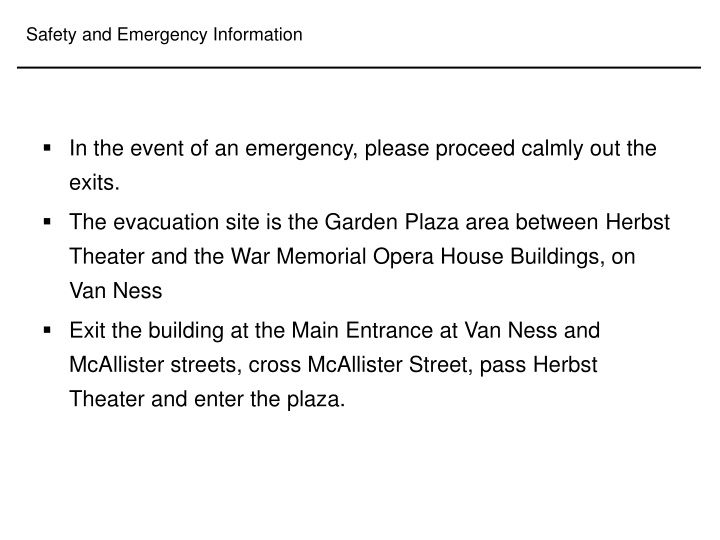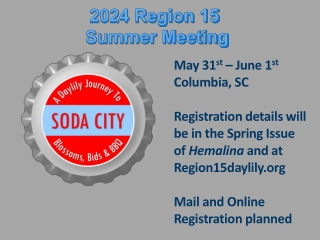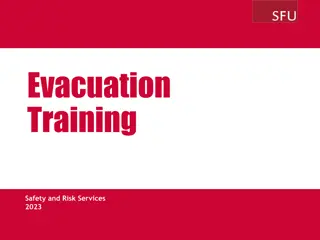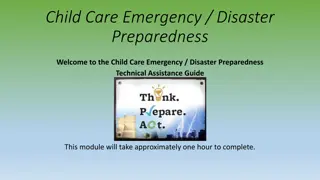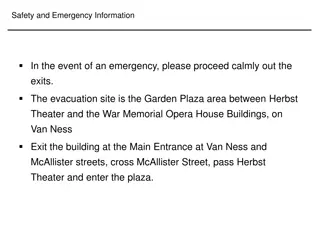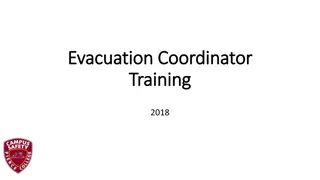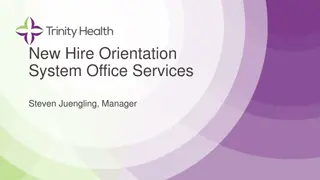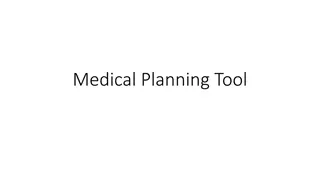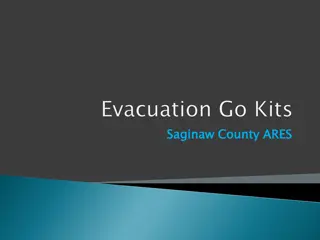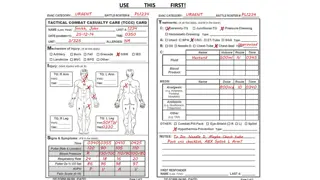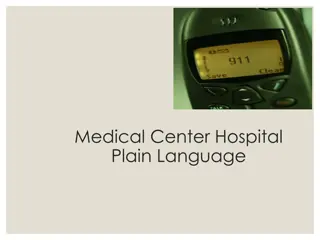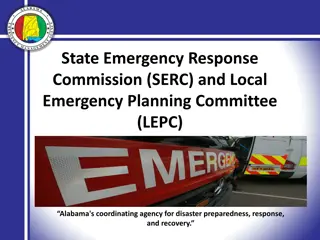Emergency Evacuation Information at The Garden Plaza
In case of an emergency, calmly proceed to the designated evacuation site at the Garden Plaza area between Herbst Theater and the War Memorial Opera House Buildings on Van Ness. Exit the building at the Main Entrance on Van Ness and McAllister streets. Follow the specified route to ensure a safe evacuation.
Download Presentation

Please find below an Image/Link to download the presentation.
The content on the website is provided AS IS for your information and personal use only. It may not be sold, licensed, or shared on other websites without obtaining consent from the author.If you encounter any issues during the download, it is possible that the publisher has removed the file from their server.
You are allowed to download the files provided on this website for personal or commercial use, subject to the condition that they are used lawfully. All files are the property of their respective owners.
The content on the website is provided AS IS for your information and personal use only. It may not be sold, licensed, or shared on other websites without obtaining consent from the author.
E N D
Presentation Transcript
Safety and Emergency Information In the event of an emergency, please proceed calmly out the exits. The evacuation site is the Garden Plaza area between Herbst Theater and the War Memorial Opera House Buildings, on Van Ness Exit the building at the Main Entrance at Van Ness and McAllister streets, cross McAllister Street, pass Herbst Theater and enter the plaza.
California Public Utilities Commission RFP 17PS5012 For Energy Efficiency Savings Measurement, Estimation, Program Oversight, and Evaluation of the Group A Sectors: Small/Medium Commercial and Residential Sectors, HVAC, and Lighting Bidders Conference March 14th, 2018
4 Agenda 01:00 01:15 Welcome & Housekeeping + EM&V Program Overview Jeorge Tagnipes, Supervisor of Commercial and Evaluation Section Energy Efficiency Branch, California Public Utilities Commission 01:15 01:30 Procurement Overview + Minimum Qualifications Michael Baltar, Contract Analyst California Public Utilities Commission 01:30 02:15 Desirable Qualifications, Rigor Protocols, and Required Deliverables Jeorge Tagnipes and Abhilasha Wadhwa Energy Efficiency Branch, California Public Utilities Commission 02:15 02:30 02:30 03:00 Deliverable Cost Sheet and Scoring Process Michael Baltar, Contract Analyst California Public Utilities Commission Questions & Answers All
Presenter: Jeorge Tagnipes 5 Housekeeping Throughout the procurement process from public comment until the contracts are awarded the CPUC will work to ensure all potential proposers have a level playing field and that the CPUC operates in a manner that is accountable to the public. The following logistics will be followed for the Question & Answers period: Out of respect for all participants, all questions will be held until the end of the conference in the time allotted for Q&A to ensure that we cover all components of the solicitation; Questions and comments received during this conference will not be recorded; Preliminary responses may be provided to questions verbally during this conference. However, no responses will be considered final or binding until they have been posted in writing; and Vendors should follow up in writing with all questions asked at this conference whether it was answered at the conference or not. Only questions submitted in writing are considered official submission and will receive a response in the official Q&A document. Signing-in and verbally identifying yourself on the voicemail is optional. If you sign-in or identify yourself on the call, A list of those who participated in the conference will be public upon the close of the procurement period.
Presenter: Jeorge Tagnipes 6 This RFP will include the following Scope of Work: For all Sectors (including residential, commercial and Industrial/Agricultural): Develop estimates for, and update the Commission s DEER database; review and approve workpapers Energy Savings Estimation For Small/Medium Commercial + Residential sectors, Lighting + HVAC Measure groups: Develop workplans and conduct market studies to inform programs, estimation and evaluation approaches Market Research Studies Measure and verify savings resulting from energy efficiency measures, programs and portfolios Impact Evaluations Seek and incorporate stakeholder feedback through public meetings, workshops and other Commission-approved processes Stakeholder Engagement
7 Agenda 01:00 01:15 Welcome & Housekeeping + EM&V Program Overview Jeorge Tagnipes, Supervisor of Commercial and Evaluation Section Energy Efficiency Branch, California Public Utilities Commission 01:15 01:30 Procurement Overview + Minimum Qualifications Michael Baltar, Contract Analyst California Public Utilities Commission 01:30 02:15 Desirable Qualifications, Rigor Protocols, and Required Deliverables Jeorge Tagnipes and Abhilasha Wadhwa Energy Efficiency Branch, California Public Utilities Commission 02:15 02:30 02:30 03:00 Deliverable Cost Sheet and Scoring Process Michael Baltar, Contract Analyst California Public Utilities Commission Questions & Answers All
Presenter: Michael Baltar 8 Procurement key dates Key Action Dates Date RFP Release Date 03/07/2018 03/14/2018 Optional Bidders Conference Location: Courtyard Room, CPUC 1:00 PM 3:00 PM PT 03/21/2018 5:00 PM PT Proposer s Written Questions Submission Deadline CPUC Written Answers Posting Date 03/28/2018 Intent to Bid Submission Deadline 04/04/2018 5:00 PM PT Proposal Response Due Date 05/02/2018 5:00 PM PT Technical and Cost Evaluation (Tentative) May 02 May 17, 2018 Notice of Intent to Award (Tentative) 05/18/2018 Deadline to submit Intent to Protest (Tentative) 05/25/2018 5:00 PM PT Deadline to submit Protest Letter (Tentative) 05/30/2018 5:00 PM PT Contract Execution Process (Tentative) 06/01/2018 6/29/2018
Presenter: Michael Baltar 9 RFP questions and feedback must be submitted by 5 P.M. Pacific Time on March 21, 2018 Proposers may require clarification of the intent or content of this RFP or matters regarding the competitive solicitation process by submitting a question or requests for requirements change during this period. Questions submitted during this period will be posted as an official Q&A document with the state s official response. CPUC will not be able to take personal meetings or respond to telephone inquiries regarding the solicitations in order to ensure a level playing field, full transparency, and the integrity of the solicitations. All correspondence, questions, inquiries should be directed to Michael Baltar at Michael.Baltar@cpuc.ca.gov. No answers provided by the Commission verbally shall be considered binding.
Presenter: Michael Baltar 10 Prime Proposers must submit a Mandatory Notice of Intent to Bid (Attachment 18) to be eligible to participate in the solicitation process Mandatory Notice of Intent to Bid Key Notes Prime Proposers must complete and return this form electronically to Michael Baltar at Michael.Baltar@cpuc.ca.gov by April 4, 2018 5 PM PT Submission of the Intent to Bid is non-binding, however, Prime Proposers who do not return this form will not meet the minimum qualifications to submit a proposal. Vendors who are not Prime Proposers, but wish to continue receive notifications for this RFP shall submit this form as a non-proposer.
Presenter: Michael Baltar 11 Proposers must meet the following Minimum Qualifications to be eligible to bid: Read and understand the Conflict of Interest provisions pertaining to the RFP. Be registered as a private entity, non-profit organization, the University of California, California State University Foundation, or other governmental entities with the California Secretary of State or can provide an explanation as to why it is not necessary. Proposer must identify all subcontractors proposed for participation in the contract, and the tasks or work areas that would be assigned to each subcontractor using Attachment 5: Bidder Declaration. Certify and agree to the bidding and subcontracting limitations; A firm submitting a proposal as the Prime Contractor for Contract Group A may not be a subcontractor on any other proposing team for Contract Group A; A firm may submit proposals as the Prime Contractor for more than one contract group, but if a firm is awarded a contract as the Prime Contractor for one contract group, this precludes their eligibility as a Prime Contractor in any other contract groups under this set of Energy Efficiency Contracts (as described in Section 1. Background of this RFP); and A firm may be a subcontractor on multiple proposals in Contract Group A, so long as the firm is not participating as a Prime Contractor on any of the Group A proposals.
Presenter: Michael Baltar 12 Proposers must meet the following Minimum Qualifications to be eligible to bid: If awarded the contract, sign a Confidentiality/Nondisclosure Statement for the use of data. Certify and agree to complete all deliverables in accordance to requirements described in the RFP and subject to the EDPM s approval and any Commission requirements. Certifies that they will adhere to theAmerican Evaluation Association s Guiding Principles for Evaluators. Complete and return the Notice of Intent to Bid (Attachment 19). Vendors who do not return this form by the date specified in Section 2.D: Key Dates will be disqualified from further participation.
13 Agenda 01:00 01:15 Welcome & Housekeeping + EM&V Program Overview Jeorge Tagnipes, Supervisor of Commercial and Evaluation Section Energy Efficiency Branch, California Public Utilities Commission 01:15 01:30 Procurement Overview + Minimum Qualifications Michael Baltar, Contract Analyst California Public Utilities Commission 01:30 02:15 Desirable Qualifications, Rigor Protocols, and Required Deliverables Jeorge Tagnipes and Abhilasha Wadhwa Energy Efficiency Branch, California Public Utilities Commission 02:15 02:30 02:30 03:00 Deliverable Cost Sheet and Scoring Process Michael Baltar, Contract Analyst California Public Utilities Commission Questions & Answers All
Presenter: Abhilasha Wadhwa 14 Proposers will be evaluated on the following desirable qualifications: Basic Expertise and Experience Demonstrate experience in successfully managing complex projects involving multidisciplinary teams to respond to client needs in a timely and competent manner; The team shall be comprised of multiple subcontractors, at least one senior experienced overall Project Manager, at least one manager for each sector and measure group, and in-house staff; and experience shall reflect the Proposer s effectiveness in managing time and resources across multiple projects, setting work plan schedule, and workflow tracking. Demonstrate experience in leading stakeholder workshops and working with energy stakeholders in a public regulatory process, and shall demonstrate success in presenting and communicating evaluation results, recommendations, and findings to related and/or non-technical audience; Demonstrate knowledge and understanding of Federal regulations, California s codes and regulations, energy efficiency policy, measure value estimation and evaluation methodologies and practices, and industry best practices. Building Simulation and Energy Modeling Skills Demonstrate expertise, capacity, and experience with whole building and measure simulation and energy modeling software, such as Open Studio/Energy Plus or eQuest/DOE-2, including: Having competency with detailed whole building energy use simulation methodologies; Capability of development and/or customization of building prototypes for different California building-type/climate zone/vintage iterations; Competency producing modeling results for commercial, residential, industrial, and agricultural energy efficiency measures having coverage for the various sub-industries and technologies therein; Incorporating existing approved deemed values into energy efficiency models; Providing documentation that makes transparent the underlying assumptions used when producing modeled results; and incorporating successive versions of building codes, federal standards, data from field studies, and national surveys into modeling and analysis methods.
Presenter: Abhilasha Wadhwa 15 Proposers will be evaluated on the following desirable qualifications: Evaluation Expertise and Experience Conducting in-depth program impact evaluation studies in a regulatory context; Developing and implementing complex study designs; Conducting analysis of quantitative and qualitative energy program data (including energy savings estimates); Performing program impact evaluations and energy policy analysis that results in actionable recommendations for program decision-makers; Developing and providing specific feedback on energy efficiency methodologies for evaluation projects; Conducting energy and demand savings estimation; and Measuring load/impact profiles, free ridership, measures effective and remaining useful life, developing net-to-gross values, gross realization rates, measure costs. Demonstrate knowledge of the process for inclusion of new technologies into the IOU EE portfolio, including workpapers, deemed and custom measure development and screening. Demonstrate experience in calculating and statistically modeling energy savings values and an ability to review, revise, and verify energy efficiency value estimates developed by third parties; and Demonstrate experience in conducting research projects on a variety of energy program topics including expertise in the multi-disciplined research areas of engineering, econometrics, behavioral and market research related to energy programs.
Presenter: Abhilasha Wadhwa 16 Rigor Protocols for Gross Impact Evaluation Rigor Level Protocol Simplified Engineering Models: The relative precision is 90/30. The sampling unit is the premise. The sample size selected must be justified in the evaluation plan and approved as part of the evaluation planning process. Normalized Annual Consumption (NAC) Models: There are no targets for relative precision. This is due to the fact that NAC models are typically estimated for all participants with an adequate amount of pre- and post-billing data. Thus, there is no sampling error. However, if sampling is conducted, either a power analysis or justification based upon prior evaluations of similar programs must be used to determine sample sizes. Basic N/A Standard Regression: There are no relative precision targets for regression models that estimate gross energy or demand impacts. Evaluators are expected to conduct, at a minimum, a statistical power analysis as a way of initially estimating the required sample size. Other information can be taken into account such as professional judgment and prior evaluations of similar programs. The sample size selected must be justified in the evaluation plan and approved as part of the evaluation planning process. Enhanced Engineering Models: The target relative precision for gross energy and demand impacts is 90/10. The sampling unit is the premise. The sample size selected must be justified in the evaluation plan and approved as part of the evaluation planning process.
Presenter: Abhilasha Wadhwa 17 Rigor Protocols for Net Impact Evaluation Rigor Level Protocol Participant self-report. Basic Participant and non-participant analysis of utility consumption data that addresses the issue of self-selection. Enhanced self-report method using other data sources relevant to the decision to install/adopt. These could include, for example, record/business policy and paper review, examination of other similar decisions, interviews with multiple actors at end-user, interviews with mid-stream and upstream market actors, Title 24 review of typically built buildings by builders and/or stocking practices. Standard Econometric or discrete choice with participant and non-participant comparison addressing the issue of self-selection. Triangulation using more than one of the methods in the Standard Rigor Level. This must include analysis and justification for the method for deriving the triangulation estimate from the estimates obtained. Enhanced
Presenter: Jeorge Tagnipes 18 There are two main types of deliverables under this RFP: The Commission-defined deliverables correspond more closely to current Commission processes and default evaluation practices. The commission has a general approach that the proposers shall consider for all Commission-defined deliverables, however, the proposers are encouraged to incorporate innovation into their approach where a narrative is required. Commission-Defined Similar work to what has been defined under this set of deliverables was completed for past program cycles and is available for review via the links provided under Section 2.H Bidders Library to provide a solid starting point to proposers as they develop their unique proposals. The Proposer-defined deliverables are intended to invite innovative approaches for work products, research, installations or creations, such that these approaches can be selected for execution individually or in combination with each other as the need arises. The approaches shall be conceptualized for different rigor levels (Basic, Standard, and Enhanced) where appropriate, and provide a cost option for each of those approach. Each deliverable shall demonstrate all possible creative approaches that they can deliver and also to allow for maximum flexibility during contract execution. During implementation, the proposed approach of the awarded contractor may changebased on the Commission Project Manager s approval and other emerging issues. Proposer-Defined
Presenter: Jeorge Tagnipes 19 Required Commission-Defined Deliverables No narrative required (Page 1 of 3) Deliverables Description 2. Progress Reports and Updates Submit monthly reports and provide updates on an as-needed basis. 3. Kickoff Meeting Attend kickoff meeting with the Commission upon award. 4. Monthly Progress Meeting Participate in monthly progress meetings with the Commission. Conduct up to 30 stakeholder engagement workshops or webinars. Be able to explain their evaluation approaches to a non-technical audience. 5. Quarterly Stakeholder Workshops & Webinars 18. Subject Matter Expert Services Advise Commission Staff as needed, on matters concerning the Energy Efficiency Evaluation efforts and EM&V Research Roadmaps. Attend ad-hoc meetings with entities such as Commission Executives, Advisory Committee, and others, to provide updates, briefings, or participate in programmatic discussions. 19. Other Meetings and Briefings The State may add an additional amount in the contract for unanticipated tasks in the event that additional work must be performed that was wholly unanticipated, and which was identified in neither the State s solicitation document nor the Vendor s proposal, but which in the opinion of both parties is necessary to the successful accomplishment of the general scope of work. These tasks will be billed at a pre-approved proposed hourly rate, subject to the EDPM s approval, and are not to exceed 10% of the total agreement amount awarded. 20. Unanticipated Tasks
Presenter: Jeorge Tagnipes 20 Required Commission-Defined Deliverables Narrative required (Page 2 of 3) Deliverables Description Create and establish research and evaluation workplans for each sector and market describing all tasks and activities necessary to complete all deliverables under this contract. 1. Research and Evaluation Workplans and Updates 6. Annual EM&V Master Plan Update & Gaps and Emerging Issues Report Submit a Gaps & Emerging Issues report by Nov 15th of each year for each sector. Conduct a dual data collection effort annually necessary to complete the review of savings estimates. Follow a stratified sampling methodology dictated by the tracking data available and other protocols determined by the Commission. 7. Data Collection and Sampling Plan Develop recommendations for program administrators to improve their energy efficiency programs, including the analysis of the program management and current IOU energy efficiency programs. 8. Program Analysis and Recommendations Develop methodologies and on-site field work that will estimate the gross unit energy savings for kWh, kW, and terms at the measure and program level. 9. Gross Savings Estimates Develop methodologies and survey instruments that will estimate the levels of program attribution and program influence at the measure and program level. 10. Net Savings Estimates Deliver final evaluation reports to the Commission by March 1st of each year. The Commission Project Manager will determine which components of the final impact evaluation report will be submitted each year. At a minimum, the final report will include impact evaluations for the uncertain measures list each year under each sector in this contract group. 11. Draft and Final Impact Evaluation Reports Document any specifications and descriptions of the datasets throughout the life of this contract and provide all data collected to the contractors and to the Commission. 12. Data Transfer and Documentation
Presenter: Jeorge Tagnipes 21 Required Commission-Defined Deliverables Narrative required (Page 3 of 3) Deliverables Description For all sectors (including residential, commercial and industrial/agricultural), develop new and updating existing DEER Ex Ante values with competence in energy simulation, modeling, and other industry leading public-domain (open source) software tools used to perform those analyses. 13. Ex-Ante Value Updates Review each Program Administrator submission of workpaper projects (estimated at 50 workpapers annually), identify high value projects with large portfolio savings contributions for submitted workpapers, and perform analysis that results in written dispositions that will inform the Commission on utility-claimed values. 14. Ex-Ante Workpaper Disposition Analysis Assist Commission staff in meeting the following ESPI deliverables: ESPI Ex-Ante Performance Review Scoring and Memorandums (workpaper and custom projects); ESPI Earnings Coefficients Development; ESPI Ex-Ante Savings Analysis; ESPI Ex-Post Savings Analysis; ESPI Non-Saving Analysis; and ESPI Resolution and Database. 15. Overall Annual ESPI Deliverables Review the effective useful life (EUL) parameter in their respective sectors to determine if any updates or adjustments need to be made. 16. Effective Useful Life Estimates and Approach Develop 8,760 hourly load shapes for measures. Propose and implement, an approach that will produce hourly impacts of measures, identifying the load reduction for each hour by measure. 17. Load Shape Data
Presenter: Jeorge Tagnipes 22 Required Proposer-Defined Deliverables (Page 1 of 1) Deliverables Description 21. Additional Small/Medium Commercial Studies Conduct an impact evaluation and program assessment report of the statewide deemed and Direct Install programs for the commercial sector. Conduct an impact evaluation report of deemed measures comprising a growing portion of the HVAC portfolio that have not been evaluated. Conduct a study and produce a report on HVAC field performance. Conduct an evaluation report of commercial quality maintenance programs that focus on the general maintenance practices in the industry. 22. Additional HVAC Studies HVAC Market Other Deemed Measures Produce a report on the persistence/maintenance of control technologies in the state. Produce a report that examines the expected impact of smart LED lamps on lighting end- use energy consumption. Produce a report to help define the market for LED troffer fixtures (all non-res LED fixtures indoor and outdoor). 23. Additional Lighting Studies HVAC Market Field Performance Evaluate and complete savings measurements and estimations from a number of residential sector downstream and midstream programs, including the following: Retail Products Platform, PG&E s mid-stream market transformation initiative; AB793 Energy Management Technologies (EMT) related programs; and Behavior programs. 24. Additional Residential Studies HVAC Market Industry Standard Practice Key Notes The contractor will conduct up tothree evaluation and studies annually relating to respective sector. At a minimum, the contractor shall have at least three approaches and its respective price option. Each evaluation and study request will be initiated by the EDPM, and the contractor will select the appropriate rigor level and approach for the study, subject to the EDPM's approval.
23 Agenda 01:00 01:15 Welcome & Housekeeping + EM&V Program Overview Jeorge Tagnipes, Supervisor of Commercial and Evaluation Section Energy Efficiency Branch, California Public Utilities Commission 01:15 01:30 Procurement Overview + Minimum Qualifications Michael Baltar, Contract Analyst California Public Utilities Commission 01:30 02:15 Desirable Qualifications, Rigor Protocols, and Required Deliverables Jeorge Tagnipes and Abhilasha Wadhwa Energy Efficiency Branch, California Public Utilities Commission 02:15 02:30 02:30 03:00 Deliverable Cost Sheet and Scoring Process Michael Baltar, Contract Analyst California Public Utilities Commission Questions & Answers All
Presenter: Michael Baltar 24 Proposers shall taken into consideration the following instructions when filling out the Deliverables Cost Sheet in Attachment 10 Cost Evaluation For this RFP, the Proposers will be evaluated on the proposed Total Evaluation Cost to ensure fair competition and allow an apples-to-apples comparison.Proposers shall include all authorized costs to perform the scope of work and state the total dollar amounts for each deliverable line item using the template provided in the solicitation. The awarded contractor will work with the EDPM upon contract execution to determine the final total contract cost. Number of Units The Commission will provide the number of units required for each commission-defined and proposer-defined deliverable for planning and/or evaluation purposes. The actual number of units may vary upon contract execution based on program needs from year to year, and based on the EDPM s approval. Milestone Deliverables Milestone deliverables under this contract can be defined as a periodic and/or progressive set of sub-deliverables throughout the contract period. For example, a milestone deliverable for Deliverable 2: Progress Reports could be one monthly report. Total cost per unit identified in this RFP cannot be modified throughout the contract period. However, milestone deliverables can be determined upon contract execution between the Contractor and the EDPM can propose modification to any milestone deliverable and its price point, subject to the EDPM s approval. Calculation For Option Years Upon contract award, total cost per unit submitted by the awarded contractor are fixed for the life of the contract and these adjusted by the Commission-defined, CPI-based escalation rate will be used to determine the total deliverable costs for option year extension, if applicable. EDPM will determine the number of units required for each deliverable for each option year. Not all deliverables may be needed if an option year is exercised.
Presenter: Michael Baltar 25 Proposers will fill out all tabs within the Deliverables Cost Sheet in Attachment 10 to detail cost for each requested deliverable Tabs Description Proposers will enter the name, title, hourly rate, and areas of expertise for all Proposer's team members. Proposer can add or subtract lines as necessary. Proposer can refer to Tab "Hourly Rates" for a list of CPUC classifications. Team Members This is a list of positions equivalent to CPUC classifications. Proposers will enter the hourly rate of team members equivalent to the listed CPUC classification. This tab is primarily used to calculate the cost for Deliverable 18: Subject Matter Expert Services. Hourly Rates Proposer will fill in Column C - Column N to reflect the Total Cost Per Unit in order to calculate Evaluation Cost for all Commission-defined deliverables. For Deliverable 9 and 10, the average cost per unit of all rigor levels will be used to calculate the total evaluation cost (Row R). This is calculated for evaluation purposes only, the final contract amount may be adjusted based on level of rigor. Commission- defined In this worksheet, Unit = Per Work Product requested by the CPUC. Proposers will fill in Column B - Column D, Approach and Cost per Unit, to calculate the total evaluation cost (Row I). This is calculated for evaluation purposes only, the final contract amount may be adjusted based on approach selected. Proposer-defined This section will be automatically populated upon completion of the previous tabs. The total Evaluation Cost is calculated for evaluation purposes only, the final contract amount may be adjusted based on deliverable approach/rigor level upon contract execution. Both the Total Evaluation Cost and the Final Contract Amount must not exceed the contract cost cap of $30 million. Total Contract Cost
Presenter: Michael Baltar 26 The contract will be awarded to the proposer whose proposal received the highest score by the CPUC evaluation and selection team Stage Scoring Description All proposals that pass the compliance check will begin Stage 1: Technical Review. The Review Panel will review all proposals to assess the Proposer s ability to carry out the proposed work. The Review Panel will review each proposal individually and then score by consensus all aspects of the following requirements: Proposer s Team Description and Experience (200 points); - Organization Description; and - Desired Qualifications. Approach and Workplan (440 points). - Workplan Narrative; and - Detailed Workplan. Stage 1: Technical Review 640 Points Proposers must obtain a minimum of 448 points in Stage 2 in order to advance to Stage 2. For proposals that passed Stage 1, all references will be contacted for this stage. CPUC will make reasonable attempts at contacting the references, and scores received from respondents will be averaged out for the final score of that element. Stage 2 : Reference Check 40 Points Each proposer s total cost for all services will be ranked from low-to-high. The proposal with the lowest total cost will received a score of 300. The remaining proposals will receive an incrementally lower score as indicated in the sample calculation in the solicitation. 300 Points Stage 3 : Cost Evaluation Stage 4: Adjustments for SB/DVBE Preferences N.A. Scores will be adjusted to account for SB and/or DVBE participation. CPUC will combine the points of each qualifying Proposer from Stage 1-4 to calculate the total score for each qualifying Proposer. The maximum point value for the scoring process is 980 points Stage 5: Combining Scores N.A.
27 Agenda 01:00 01:15 Welcome & Housekeeping + EM&V Program Overview Jeorge Tagnipes, Supervisor of Commercial and Evaluation Section Energy Efficiency Branch, California Public Utilities Commission 01:15 01:30 Procurement Overview + Minimum Qualifications Michael Baltar, Contract Analyst California Public Utilities Commission 01:30 02:15 Desirable Qualifications, Rigor Protocols, and Required Deliverables Jeorge Tagnipes and Abhilasha Wadhwa Energy Efficiency Branch, California Public Utilities Commission 02:15 02:30 02:30 03:00 Deliverable Cost Sheet and Scoring Process Michael Baltar, Contract Analyst California Public Utilities Commission Questions & Answers All
Presenter: Jeorge Tagnipes 28 Questions & Answers Questions and comments received during this conference will not be recorded. Preliminary responses may be provided to questions verbally during this conference. However, no responses will be considered final or binding until they have been posted in writing. Vendors should follow up in writing with all questions asked at this conference whether it was answered at the conference or not. Only questions submitted in writing are considered official submission and will receive a response in the official Q&A document.
29 Thank You for Participating! All Questions and comments shall be submitted to Michael Baltar at Michael.Baltar@cpuc.ca.gov
